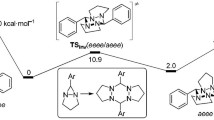Abstract.
Triprismane, a C6H6 isomer of benzene, belongs to a class of strained hydrocarbons. In this work, the energy and charge distributions in a series of aza (C6N α H6− α ) and nitroaza (CNO2)6− α N α , (with α=1...6) derivatives of triprismane have been analyzed using the ab initio Hartree–Fock (HF)-derived molecular electrostatic potentials and molecular electron densities. Electrostatic potential investigations have shown that the electron-rich regions around nitrogen along a series of azatriprismanes and those near oxygens of nitro group in nitroazatriprismanes become smaller on encompassing from the hexanitroaza to nitroazatriprismane. As revealed from the molecular electrostatic potential (MESP) topography for the series of azatriprismanes the MESP minimum near nitrogen become shallow with increasing nitrogen content. Heats of formation obtained from the isodesmic reaction approach in the C6N6H6− α and (CNO2)6− α N α series correlate well with the electron density at the bond-critical point of the X— N (X = C or N) bonds of the triprismane framework.
Similar content being viewed by others
References
Katz TJ, Acton N (1973) J Am Chem Soc 95:2738
Schultz HP (1965) J Org Chem 30:1361
Dai YA, Dunn K, Boggs JE (1984) J Mol Struct 109:127
Politzer P, Jayasuriya K, Zilles BA (1985) J Am Chem Soc 107:121
Politzer P, Seminario JM, Concha MC, Murray JS (1993) Theor Chim Acta 85:128
Engelke R (1989) J Phys Chem 93:5722
Engelke R (1992) J Phys Chem 96:10789
Murray JS, Seminario JM, Lan P, Politzer P (1990) J Mol Struct 207:193
Murray JS, Redfern PC (1993) Struct Chem 4:73
Murray JS, concha M, Seminario JM, Politzer P (1991) Phys Chem 95:1601
Gimarc BM, Zhao M (1996) Inorg Chem 35:3289
Frisch MJ, Trucks GW, Schlegel HB, Gill PMW, Johnson BG, Robb MA, Cheeseman JR, Keith T, Peterson GA, Montgomery JA, Raghavachari K, Al–laham MA, Zakrzewski VG, Oritz JV, Forseman JB, Cioslowski J, Stefanov BB, Nanayakkara A, Challacombe M, Peng CY, Ayala PY, Chen W, Wong MW, Andres JL, Replolge ES, Gomperts R, Martin RL, Fox DJ, Binkley JS, Defrees DJ, Baker J, Stewart JJP, Head–Gordon M, Gonzalez C, Pople JA (1995) Gaussian 94. Gaussian Inc., Pittsburgh, PA
Pulay P (1969) Mol Phys 17:197
Becke D (1993) J Chem Phys 98:5684
Lee C, Yang W, Parr RG (1988) Phys Rev B37:785
Scrocco E, Tomasi J (1978) Adv Quantum Chem
Tomasi J, Bonaccorsi R, Cammi R (1991) In: Maksic ZB (ed) Theoretical models of chemical bonding, vol 4. Springer, Berlin Heidelberg New York, p 228
Naray-Szabo G, Ferenczy GC (1995) Chem Rev 4:829
Limaye AC, Gadre Sr (2001) Curr Sci (India) 80:1298
Gadre SR, Shirsat RN (2000) Electrostatics of atoms and molecules. Universities Press, Hyderabad
Gadre Sr, Shrivastava IH (1991) J Chem Phys 94:4384
Gadre SR, Kulkarni SA, Shrivastava IH J Chem Phys (1992) 96:5253
Cremer D, Kraka E (1985) J Am Chem Soc 107:3800
Grimme S (1996) J Am Chem Soc 118:1529
Author information
Authors and Affiliations
Corresponding author
Additional information
SPG is grateful to the Council of Scientific and Industrial Research (CSIR project 01(1772)/02/EMR-II), New Delhi, India. KAJ thanks CSIR for the Junior Research Fellowship. Thanks are due to C-DAC, Pune, for providing computational facilities.
Rights and permissions
About this article
Cite this article
Gejji, S., Joshi, K. Molecular electrostatic potentials and electron densities in azatriprismanes and nitroazatriprismanes. Theor Chem Acc 113, 167–177 (2005). https://doi.org/10.1007/s00214-004-0621-0
Received:
Accepted:
Published:
Issue Date:
DOI: https://doi.org/10.1007/s00214-004-0621-0




